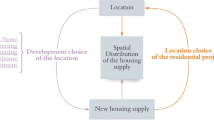Abstract
In the Netherlands, housing construction isvery much in the domain of public policy:quantity, quality and location of housing aresubject to public choice. In order to evaluatepossible locations and possible compositions ofthe housing construction in terms of dwellingtypes, the effects of alternative housingconstruction programmes have been simulatedusing a dynamic housing market simulation model– Socrates.With the same demographic and economicbackground, three housing constructionprogrammes were evaluated in terms of changesin concentration of certain household types(elderly, one-person, and low-incomehouseholds). The first one is a `continuationof current policy' variant. The second is the`demand' variant, in which housing constructionfollows housing demand. The third is arestrictive variant, in which housingconstruction follows demand, but within certainspatial restrictions.The results show that in the course of thecurrent and next decades a certainlevelling-off of existing concentrations willoccur. These tendencies are, however, onlymarginally affected by alternative housingconstruction programmes; demographic andeconomic trends have far greater impact on theconcentration of certain household types.
Similar content being viewed by others
References
CPB (1997) Economie en fysieke omgeving. Beleidsopgaven en oplossingsrichtingen 1995-2020 (Economy and the Physical Environment. Policy Issues and Directions for Solutions 1995-2020), Centraal Planbureau, Sdu Uitgevers, The Hague.
Deurloo, R. and Dieleman, F. (1989) Statistische analyse van gegevens van laag meetniveau. Een illustratie op het gebied van de woningkeuze van huishoudens (Statistical Analysis of Low Level Measurement Data. Illustration using Housing Choice of Households), In: Methoden voor woning-en woonmilieubehoefte-onderzoek (Research Methods for Housing and Residential Preferences) (Ed, Musterd, S.), SISWO Publikatie 340, SISWO, Amsterdam.
Heida, H. and Hooimeijer, P. (1995) Household Projections and Housing Market Behaviour, In: Household Demography and Household Modelling (Eds, Van Imhoff, Kuijsten, Hooimeijer and Van Wissen), Plenum, New York.
Heida, H., Poulus, C., Brouwer, J., Gras, R., Oskamp, A. and Den Otter, H. (2000) Methodiek Nota Mensen, Wensen, Wonen (Methodology Housing Document), R00/040, ABF Onderzoek en Informatie, Delft.
Musterd, S. and Ostendorf, W. (1995) Grote steden: maatschappelijke dynamiek en ruimtelijke segregatie (Large Cities: Social Dynamics and Spatial Segregation), AME, University of Amsterdam.
Oskamp, A., Poulus, C. and van Til, R.-J (2000) Bevolkingsgroepen in stad en ommeland - ruimtelijke implicaties van woonvoorkeuren en bouwbeleid (Population Groups in and Around Cities - Spatial Implications of Housing Preferences and Construction Policy), R00/023, ABF Onderzoek en Informatie, Delft.
Van Daalen, G., Deurloo, R. and Musterd, S. (1995) Segregatie op microniveau (Segregation at the Micro Level), AME, University of Amsterdam.
VROM (2000), Nota Mensen, wensen, wonen. Wonen in de 21e eeuw (Housing Document. Housing in the 2st Century), Ministry of Housing, The Hague.
Author information
Authors and Affiliations
Rights and permissions
About this article
Cite this article
Oskamp, A., Poulus, C. & van Til, RJ. Spatial concentration and deconcentration of household types in the Amsterdam region Effects of three scenarios of new construction . Journal of Housing and the Built Environment 17, 321–335 (2002). https://doi.org/10.1023/A:1020206224388
Issue Date:
DOI: https://doi.org/10.1023/A:1020206224388




